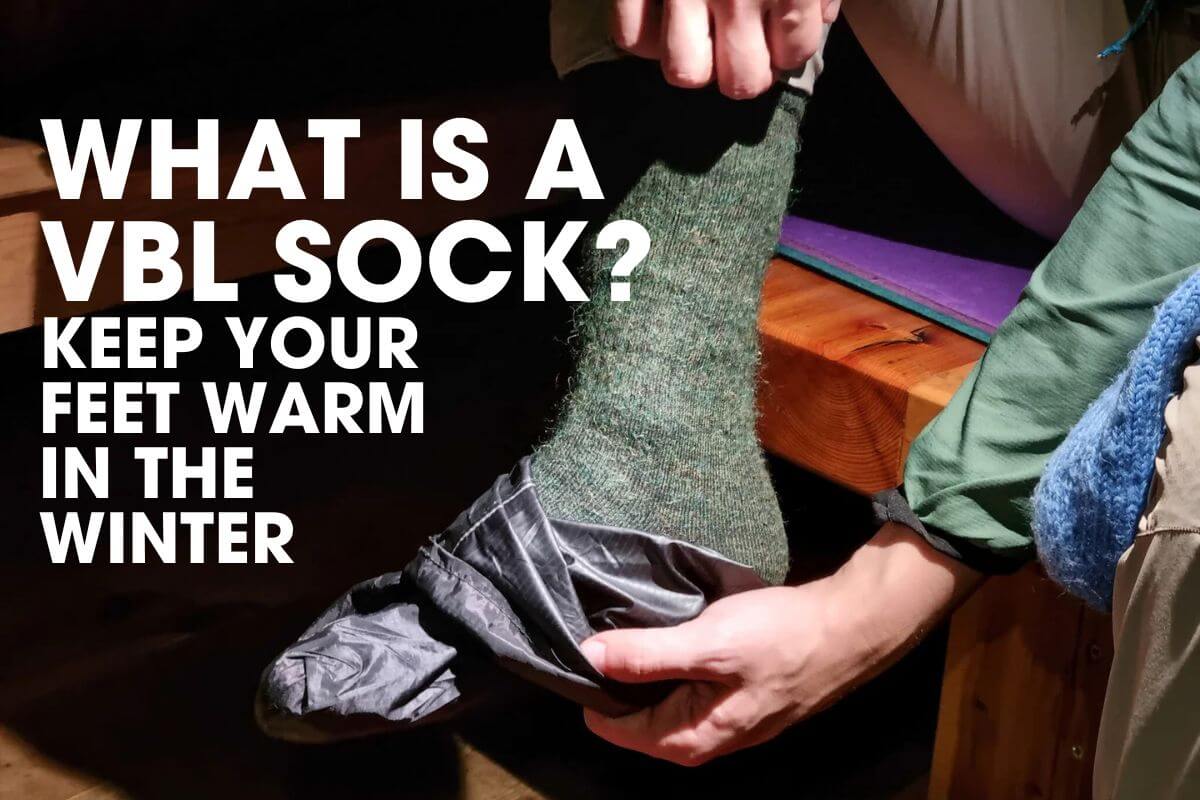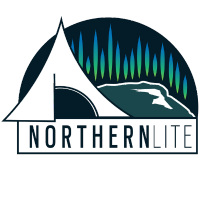Vapor Barrier Layer (VBL) Socks – Keep Your Feet Warm in Winter!

Written by: Northern Lite designer Teemu Hartikainen
Image credits: Rinkka ja Pulkka
What are Vapor Barrier Socks and What are they Used For?
One of the challenges of winter trekking is keeping feet warm and winter boots dry. Even warm boots start to cool down during the day, and stiffen due to moisture accumulating inside them, and then freezing. This moisture does not come from the outside, but from inside the boot—sweat evaporating from the feet. Eventually, the boots freeze, becoming uncomfortable and cold, and in the morning, they are difficult to put on. Cold boots risk cold-related injuries and make trekking uncomfortable.
Vapor Barrier Layer (VBL) socks are a brilliant tool that keeps winter boots and ski boots dry. Thanks to a VBL sock, moisture evaporating from the foot does not reach and freeze inside the boot, keeping the feet warm! VBL socks are one of the most important pieces of equipment for winter trekkers.
In this article, we guide you on how to use and choose vapor barrier socks. We will also briefly introduce the new Northern Lite VBL socks, which solve many of the previous issues with VBL socks.

What is a VBL Sock, and How Does it Work?
A VBL sock is a completely waterproof and non-breathable sock that creates a moisture-proof layer around the feet. This "vapor barrier" prevents sweat moisture from moving into outer layers such as wool socks or ski boots. VBL socks ensure dry ski boots and warm feet.
The Benefits of VBL Socks
-
Feet stay warm – The vapor barrier retains body heat and prevents moisture from cooling down, stopping moisture from freezing inside the boot.
-
Boots stay dry – Boots and ski boots do not get wet from the inside, extending their lifespan and increasing comfort on long trips.
-
Moisture can be managed using thin base socks – A base sock is worn under the VBL sock, making them more comfortable to use. You can also manage moisture by changing only the base sock, which then is easy to dry.
The most effective way to protect boots and ski shoes from moisture is to use a vapor barrier between the foot and the ski boot. When the foot is enclosed in a waterproof shell, moisture cannot transfer from the foot into the ski boot and wool sock. The boots stay dry and, therefore, warm throughout the trip. The only thing left to dry is the thin base socks, rather than thick boots and socks. Layering is important for feet as well!
Are VBL Socks Hygienic?
Using VBL socks essentially means wearing plastic bags on your feet. This idea may sound questionable, but the principle works.
If the idea of wearing a plastic bag on your foot seems strange or gross, you're not alone—when using VBL socks, foot hygiene is crucial. However, foot hygiene is often neglected on ski expeditions unless VBL socks encourage more frequent foot washing. Feet should be washed regularly at camp, for example, by heating a small amount of water on a stove when doing other washing or melting snow.
Well-made vapor barriers are straightforward, easy, and comfortable to use, providing significant benefits for keeping feet warm. Using VBL socks can even promote better foot hygiene on winter treks. At the same time, feet are examined more thoroughly, helping to prevent blisters and frostbite.
How Much Do Feet Sweat During Winter Trekking?
Even if you don't usually feel like your feet sweat much, you'll notice your ski boots stiffening as the trek progresses—especially in the morning when putting them on. This often results from moisture accumulating in the boot, making it tough to fit your feet in the frosty boots. It may also take considerable time to get the boots warm again. All the while risking blisters and chafing from stiff, cold boots.
The human body releases about 600 grams of moisture per day at rest through the skin, in addition to what is exhaled from breath. Some of this water vapor is excreted through the feet. If this vapor is not sealed near the skin, it will eventually soak the boots, making them cold and stiff.
During intense activity, increased sweating promotes moisture release from the feet. VBL socks help manage this moisture and keep feet warm.

How to Keep Ski Boots Dry on a Winter Trek?
Many believe that without removable inner boots or felt liners, it is impossible to ski in the wilderness for multiple days because boots cannot be easily dried. This is not a concern when using Vapor Barrier socks.
Since ski boots do not get wet from sweat, they do not need to be dried in the first place. This is not possible with any other method besides a vapor barrier—otherwise, one must rely on drying the boots, which is not always possible, and can risk damage to the boots from a hot stove.
VBL Socks or Removable Felt Liners?
VBL socks are especially essential with BC (backcountry) ski boots, most of which do not have a removable liner for easy drying. By using VBL socks, one can more freely choose stiffer backcountry bindings and boots instead of heavier and more sloppy felt-lined boots. This improves skiing efficiency on snow, and increases control on slopes.

Plastic Bags or VBL Socks?
Instead of VBL socks, simple plastic bags can be used as vapor barriers. We have personally skied thousands of kilometers relying on plastic bags. However, they are quite disposable and require frequent adjustments on the foot.
If the vapor barrier concept is new to you, you can test it before investing in gear by placing large garbage or freezer bags on your feet. Even a shopping bag will do. When choosing a bag, ensure the bottom seam is a few centimeters longer than your foot.

Instructions for Using VBL Socks
It is recommended to wear a thin, non-restrictive base sock under VBL socks to enhance comfort. Thin merino, polypropylene or alpaca wool socks work well for this purpose. Recently, we have preferred the Helle alpaca wool socks from the Finnish brand Wølmark, as they are slightly thicker than the thin merino socks we used previously but still dry faster. Alpaca wool also does not cause the same wool allergy symptoms that I have experienced with merino wool - and it prevents smells.
When the VBL sock is worn over a base sock, it is not directly against the skin—this increases comfort and makes moisture management easier.
If your feet are prone to blisters, it is advisable to preemptively tape the most common friction areas before the first ski days. The smooth surface of the VBL sock helps reduce friction, but since the feet remain moist, it is essential to protect the most sensitive areas, such as the heels.

A thick and loose wool sock should typically be worn over the VBL sock. This protects the thicker sock from foot sweat, keeps the foot warm, and also helps keep the VBL sock in place.
Once the feet are fully layered with socks, they are placed into the ski boots, which are then adjusted according to the weather conditions. Now you're ready to ski!

How to Keep Socks Dry on a Winter Trek?
It is a good idea to bring 2–3 pairs of base socks for a winter trek—one pair on your feet, one spare pair, and one dry backup pair. Additionally, carrying at least two pairs of thicker wool socks is recommended—one in use and another packed in a waterproof bag as a reserve.
If your base socks become damp while skiing during the day, you can switch to a dry pair during lunch breaks. If the weather allows, it is also a good idea to let your feet air out while eating and apply tape to blister-prone areas. In extreme cold or poor weather, changing socks mid-day may not be necessary unless your feet clearly feel uncomfortable - but it may still be a good idea to check on them.
Since VBL socks prevent moisture from reaching the boots, the moisture instead accumulates inside the VBL sock. After removing the VBL socks, they should be left to cool for a moment before turning them inside out and shaking off the frozen moisture. After a break, turn them back right-side out and put them on over a dry pair of base socks.
Base socks do not become soaking wet from sweat, but they do get slightly damp. A thin base sock dries easily over the course of the day or evening using body heat. Damp base socks should be placed inside clothing layers close to the body, such as on the thighs or shoulders, to dry.

Drying Socks at Camp
Upon arriving at camp, socks that have become damp in the afternoon can be dried overnight by placing them between base layers on the shoulders. This way, the evaporating moisture escapes through the sleeping bag’s hood, and by morning, the base socks are dry and warm, ready to be worn again. You should keep away from drying liners deeper in the sleeping bag, to prevent losing its insulation properties due to added moisture.
It is also essential to keep feet warm inside the sleeping bag at night by wearing clean socks, such as wool socks. If your feet tend to get cold easily, insulated booties are a great addition for extra warmth.
Waterproof Socks vs. VBL Socks
It is important to note that "waterproof socks", such as SealSkinz, do not function in the same way as VBL socks. This is because they achieve their waterproofing using a breathable membrane—while water is kept out, water vapor from the foot can still pass through the membrane into the boot, leading to moisture buildup.
A VBL sock (Vapor Barrier Layer sock) is a completely waterproof and non-breathable sock, designed specifically to keep winter boots dry. The material does not breathe in either direction, meaning no moisture escapes from the foot into the boot.
The same technology is used in Northern Lite’s rain jackets, which are fully waterproof but rely on zippered vents instead of breathable membranes. This design creates a more reliable and durable waterproofing solution compared to breathable fabrics.
What Makes a Good VBL Sock?
There have been two main VBL sock models on the market, Rab and Exped. After using plastic bags as a DIY solution, we tried both of these models but quickly returned to using plastic bags.
-
The Rab socks' seam tape on the sole soon started peeling off.
-
The Exped socks did not fit well—they were too baggy in width but still tight around the ankle.
-
The materials of both socks failed to contain moisture effectively over long periods.
-
The toe shape of both brands was poorly designed, fitting more like a stuffed toy foot than a human foot.
Since people have two differently shaped feet, why are VBL socks designed identically, ensuring they squeeze the big toe?
Additionally, a 5,000mm water column rating is not sufficient for a VBL sock because the entire body’s weight is pressing down on the material.
It shouldn’t be that a garbage bag is the best solution!
After a 52-day ski trek across Sweden, I had grown tired of disposable plastic bags and constantly having to adjust them. Returning from that trip in spring 2022, I started designing better VBL socks, and by early 2025, Northern Lite VBL socks were ready for sale.
The final test? Skiing across Norway in winter 2024 with prototype VBL socks. The result was excellent, and durability exceeded expectations—VBL socks were finally ready.
Northern Lite VBL Socks: A New Era of Vapor Barrier Socks

Northern Lite VBL socks were developed specifically for demanding winter conditions. Their design is based on feedback from previous VBL sock models and aims to solve common issues.
-
Tailored design: Socks are shaped separately for the left and right foot, ensuring a better fit without uncomfortable pressure on the toes.
-
Color-coded heel loops: Right and left socks are marked with different colors for easy identification. The heel loop also allows for quick adjustments during the day if the sock starts shifting inside the boot.
-
Durability: Northern Lite Vapor Barrier Layer socks are significantly more waterproof and durable than other VBL socks or plastic bags. Seams are strategically placed to avoid high-wear areas and do not cause pressure points on the foot.

Compared to other VBL socks, Northern Lite socks have multiple times better water resistance. The same 20,000mm water column fabric is used in Northern Lite’s Superlite rain jackets and waterproof mittens.
Despite their durability, Northern Lite VBL socks are incredibly lightweight—just 30 grams per pair!

The Risks of Cold Feet – Why Foot Protection Matters
Frostbite is an obvious risk in winter trekking, but cold injuries can also occur at above-freezing temperatures. If feet stay cold and wet for extended periods, there is a hidden risk of immersion injuries, such as trench foot.
Keeping your feet warm is essential. Moisture in the sock is not a problem as long as the feet remain warm. This is why ski boots or hiking boots should never be allowed to freeze—once frozen inside, they cool rapidly and lose insulation effectiveness.
Prevent Cold Injuries on a Winter Trek
-
Prevent moisture from accumulating in boots – VBL socks keep boots and wool socks dry, which greatly helps retain warmth.
-
Monitor your feet throughout the day – If they start getting cold, add or change socks before it's too late. More than 8 hours of combined cold and moisture increases the risk of immersion injuries significantly.
-
Treat blisters as potential frostbite risks – If a blister forms, assess whether it might actually be a cold injury instead.
-
Dry your gear whenever possible – With VBL socks, socks can always be dried using body heat, while boots stay safely warm and dry.
If your feet start feeling cold:
-
Loosen your ski boots – Tight boots restrict circulation.
-
Increase movement – A few minutes of fast skiing in deep snow can help pump warm blood into the feet.
-
Take short ski breaks – Ironically, skiing reduces blood flow to the toes, so stopping periodically allows better circulation in the toes.
When using VBL socks, moisture can be controlled throughout the day, unlike in damp boots where simply changing wool socks is ineffective. The key is to keep feet warm—since some moisture is inevitable, warm feet mean a low risk of frostbite or cold injuries. This can be easiest achieved by using vapor barrier socks.

Northern Lite VBL Socks: A New Generation of Vapor Barrier Socks
Northern Lite VBL socks have been specifically developed for demanding winter conditions, taking into account user experiences from previous VBL sock models.
-
Tailored design – The socks are shaped separately for the left and right foot, ensuring a better fit without tight spots on the toes. No cutting costs here!
-
Color-coded heel loops – Right and left socks are marked with different colors for easy identification. The heel loop also makes it easy to adjust the sock during the day if it starts to slip
-
Durability – Northern Lite VBL socks are made significantly more waterproof and durable than other VBL socks and plastic bags
Compared to other VBL socks, Northern Lite socks have multiple times better water resistance. The same 20,000mm water column fabric is used in Northern Lite’s Superlite rain jackets and waterproof mittens.
VBL Socks in Emergency Situations: Warmth and Protection Even in Wet Boots
In winter trekking, unexpected situations can quickly change the tone of your trip, from a blissful nature experience to a survival situation. Boots can get wet from external causes: a boot membrane can fail, you might step into a creek, or fall into slush on a frozen lake. In freezing conditions, wet boots can quickly lead to a dangerous situation.

In such cases, VBL socks can be a crucial safety tool to protect feet from cold. Dump the water out, and wear your dry pair of thicker wool socks in the liners, while skiing to safety. VBL-socks buy you time to reorient yourself, while keeping your feet warm, even in damp boots.
Want to make your winter treks even more comfortable? Try vapor barrier socks and experience the difference yourself!
Article Contents
What is a VBL sock, and how does it work?
The benefits of VBL socks
Are VBL socks hygienic?
How much do feet sweat during winter trekking?
How to keep ski boots dry during a winter trek
VBL socks vs. removable felt liners
Plastic bags vs. VBL socks
How to use VBL socks
How to dry socks during a winter trek
Waterproof socks vs. VBL socks
Experiences with VBL socks – What makes a good VBL sock?
The risks of cold feet – Why protecting feet from cold is important
VBL socks in emergency situations: warmth and protection even in wet boots



